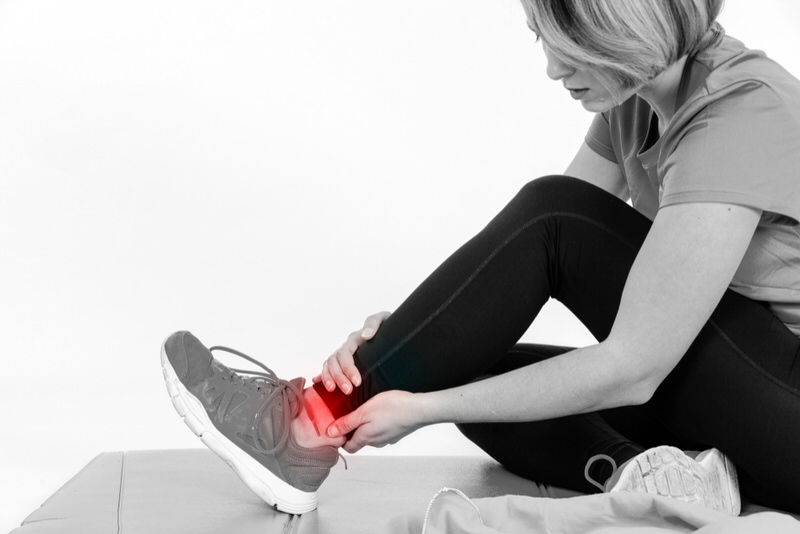Many factors can cause swollen ankles, including long periods of inactivity, dehydration, low cabin pressure, sudden weather changes, and food low in magnesium or high in salt. Staying active during long hours of travel is of utmost importance. Keeping your body in movement in between is highly recommended. There are several precautions you can take to avoid swollen ankles. There are ways to reduce swelling even if you get them, but visiting your doctor is necessary if things worsen.
Traveling is always physically and mentally draining. While you can still prepare yourself mentally for the travel you’re about to do, physically, many things can go wrong.
But one such thing that often happens to people who love to travel is getting swollen feet or ankles. Apart from this, frequent travelers also suffer from jet lag a lot too.
So, why do your ankle and foot swell whenever you travel? Is it something you’re doing wrong? Are there precautions you can take before embarking on your destination?
Let’s see what causes your ankle to swell up, how you can take care of it, and what precautions you can take to avoid it!
Traveling and ankle swelling
For traveling from one place to another, people most often take a flight to reach their destination. On a flight, you have to sit on your seat for long periods of time.
Depending on the time taken to get there, you will have to sit without much room to move.
When sitting on your seat for a long time, the normal muscles that help pump fluid out of your legs are not active.
This results in blood pooling in your feet, which causes your ankle to swell up, foot swelling, or leg swelling.
Edema (ankle swelling)

It’s known as edema when excessive fluid trapped in your body’s tissue causes your ankle to swell up.
When you’re sitting in a position for too long, which often happens when you’re traveling, it causes a restriction in your blood flow in your leg veins. This accumulation of blood in your feet and ankles is due to gravity and inactivity.
If you don’t even switch up your leg position, it further increases pressure in your leg veins. It contributes to foot swelling by causing fluid to leave the blood and move into the surrounding soft tissues.
The buildup of fluid isn’t painful unless caused by other factors like an injury. For example, ankle swelling is one of the most common edemas, but it also causes one’s foot and a leg to swell up.
Symptoms
- The tissue is swelling or puffiness directly under your skin, especially in your ankles, foot, or arms.
- Stretched or shiny skin.
- Skin that retains a dimple (pits) after being pressed for several seconds.
- Increased abdominal size.
Heat edema
Heat edema is a specific swelling that happens due to high temperatures, such as on a beach.
People who travel to a beach for their vacations don’t realize that the temperature of such a place is hot and humid, very different from where they’re living.
Heat causes blood vessels to expand, so gravity moves body fluid into the hands, legs, and ankles.
It usually happens to people who aren’t used to the hot climate of beaches. With a sudden change, their body can’t adapt too quickly, and thus ankle swelling might occur.
Other causes for ankle swelling
- In a flight, the low cabin pressure and the dry air circulating may also hamper your normal blood circulation and cause your ankle to swell.
- If you don’t keep yourself hydrated, your blood gets thicker, further affecting your blood circulation.
- The food you consume while traveling could also cause your ankle swelling, like eating sodium-filled, unhealthy food can make you feel bloated and swollen on the face and tummy. Your eating pattern can make your body parts swell up, including swollen ankles or swollen feet.
Ways to reduce ankle swelling

If you’re currently suffering from swollen ankles, then these are some of the helpful tips to reduce the swelling effectively and quickly:
1. Wear compression socks
Compression socks provide a gentle squeeze to your swollen ankles and legs at the same time.
Wearing these socks will promote blood circulation in your legs and ankles. In addition, it will further prevent fluid from pooling in your ankles, which caused the swelling in the first place.
You can buy compression socks from any store or pharmacy. They come in a variety of weights from light, medium, and heavier weight.
For ankle swelling, lightweight socks should do the trick. Wear as long as they are comfortable and reduce the swelling.
2. Elevate your legs
As mentioned before, gravity plays a significant role in causing your ankles to well up and will never stop contributing.
It’s essential to keep your swollen ankles elevated above the level of your heart to drain the built-up fluid from your ankles.
It’s like supporting your ankles to provide it relief from the pooled-up fluid in your ankles. Doing so will improve your blood circulation. You can elevate your legs by using pretty comfortable pillows.
3. Salt water
One home remedy that reduces swollen ankles or swollen feet is by soaking them in a tub of warm salt water for 15-20 minutes twice a day.
Doing this for 2-3 days will eradicate the swelling. After that, using salt in warm water for your ankles works like a charm as it reduces inflammation and draws out toxins.
4. Magnesium-rich food
Swelling in your ankle could also be a sign of magnesium deficiency which only got more heightened during your travel.
You should add magnesium-rich foods to your diet, including nuts and seeds, legumes, fiber-rich whole grains, low-fat dairy products, greens, or dark chocolate.
Ways to prevent ankle swelling
To prevent ankle swelling entirely, here are some tips while traveling:
- Hydration is the key to most problems in life, including swelled-up ankles. When you’re low on the water, your body holds on to other fluids leading to swelling due to retention. Drinking plenty of water will flush excess sodium as well as other waste from your body.
- Remember to stretch your legs as much as you can, especially when in the airplane cabin. Stretch before, after, and even during long flights. Your muscles need to stay aware that they still have to work by reminding them with a stretch. Change your leg positions frequently while sitting.
- When on a long flight, it’s better to get up and walk around too. You can go to the washroom and wash your face and stretch a little in there, but only when you think it’s safe. In the flight, you’re in a tight space, so stretch a bit. Doing this will help you immensely.
- If you can’t get up to walk around, take off your footwear (don’t if you have smelly feet) and massage your feet a little.
- Maintain a healthy routine exercise helps in the long run, especially when traveling. When your body is accustomed to movement every day via workouts, your muscles are trained and won’t forget their job even during a long plane journey. If you usually stay inactive, it’ll be more difficult while you travel.
- Reduce your intake if you take a lot of salt in your food. Salt retains fluid in your body.
- Avoid wearing a garter or any accessory on any part of your legs which are tight and can restrict your blood circulation. Wear loose-fitting clothes.
- Avoid drinking alcohol and taking sedatives.
FAQs
When should I be concerned about swollen ankles?
Try to see if the swelling goes away by elevating your legs, using warm salt water to treat them, and reducing your salt intake for about 3-4 days.
If your ankles are still swollen and you don’t see any improvements, accompanied by more pain or discoloration, you should visit your doctor. It can lead to complicated issues like deep vein thrombosis.
What to eat to reduce swelling in feet?
Your diet should be magnesium-rich and low on salt to help you see any improvements in your swollen feet. Salt retains water in your body, so it’s essential to limit your salt intake. Magnesium-rich foods include tofu, spinach, dark chocolate, almonds, cashews, etc.
Does walking help swollen ankles?
Walking helps with swollen ankles. As long as you remain active, your ankles won’t swell up. Long periods of inactivity are responsible for swollen ankles as one’s blood circulation is greatly hampered.
To summarize
Whenever you’re traveling, you have to pay proper attention to your body and make sure you don’t let your leg muscles go inactive for a long time. While inactivity is one factor, other factors are also responsible for your swollen ankles.
Sitting down for a long time when traveling can hamper your blood circulation to a great extent. It would be best if you remembered to keep moving in between to facilitate your circulation. There are several precautions you can take to avoid swollen ankles. Even if you do get them, there are ways you can reduce swelling in your ankles.
So, keep hydrated, maintain a good diet and keep moving your body, and most importantly, enjoy your travel and vacation!


